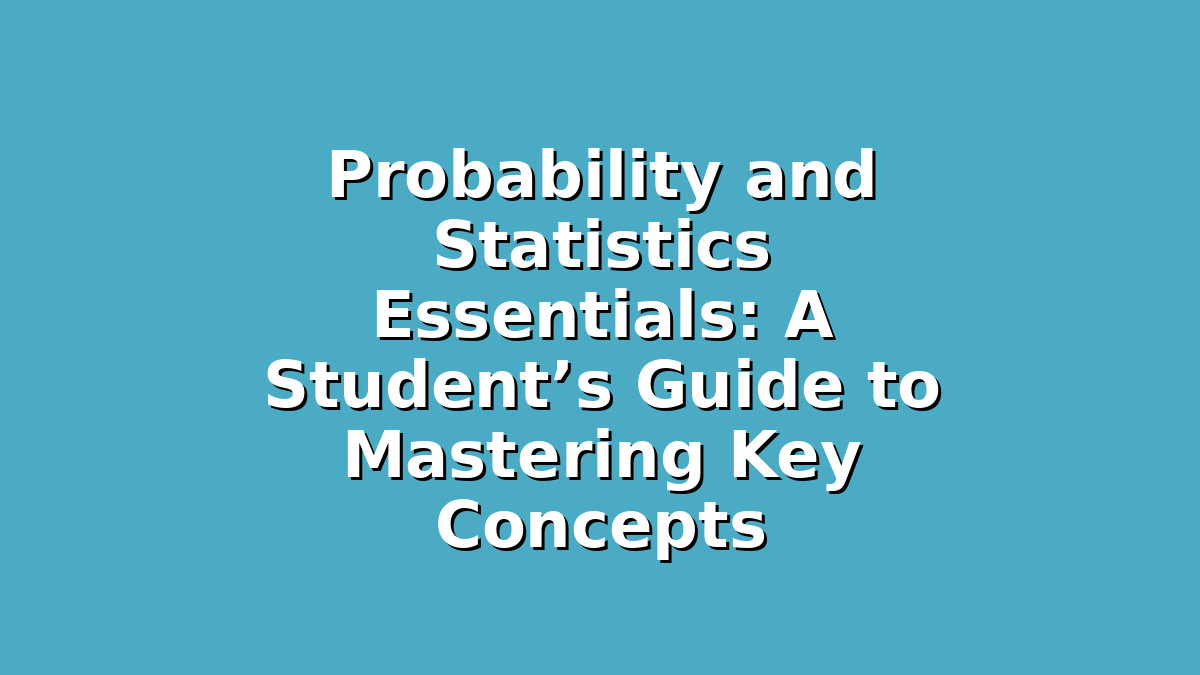Preparing for exams in probability and statistics can feel overwhelming, especially when you encounter formulas, graphs, and data interpretations that seem complex at first glance. However, with the right approach and study strategies, you can build confidence and excel in these important topics. This guide is designed specifically for students preparing for exams or those who want to strengthen their understanding of probability and statistics. Here, we’ll break down the essentials, offer practical study tips, and help you develop skills that will boost both your knowledge and your exam performance.
Understanding the Foundations: Key Concepts in Probability and Statistics
Success in probability and statistics starts with grasping the fundamental concepts. These subjects are closely related but focus on different aspects of analyzing data and measuring uncertainty.
Probability measures the likelihood of an event happening. It’s expressed as a number between 0 and 1, where 0 means the event cannot happen, and 1 means it is certain. For example, the probability of flipping a coin and getting heads is 0.5.
Statistics involves collecting, analyzing, and interpreting data. It helps us make sense of information by summarizing it with measures such as mean (average), median, mode, variance, and standard deviation.
Here are some essential topics to understand:
– Basic Probability Rules: Including addition and multiplication rules, mutually exclusive events, and independent events.
– Random Variables: Understanding discrete vs. continuous variables.
– Probability Distributions: Such as binomial, normal, and Poisson distributions.
– Descriptive Statistics: Measures of central tendency and spread.
– Inferential Statistics: Hypothesis testing, confidence intervals, and p-values.
Study Tip: Create a glossary of terms and formulas. Writing definitions and formulas in your own words helps reinforce understanding. Use flashcards for quick review and test yourself regularly to build recall.
—
Effective Study Techniques for Probability and Statistics
Many students find probability and statistics challenging because they involve both conceptual understanding and computational skills. To tackle these challenges, it helps to use study techniques that promote active learning and problem-solving.
1. Practice with Real Problems
Statistics and probability are best learned by doing. Work through as many practice problems as you can, especially those from past exams or textbook exercises. Start with simpler questions to build confidence, then gradually increase the difficulty.
When you solve problems, don’t just aim to get the right answer. Focus on understanding why a particular method works. For instance, when calculating the probability of combined events, ask yourself why you add probabilities in some cases and multiply in others.
2. Visualize Data and Problems
Graphs and charts are essential in statistics. Practice interpreting histograms, box plots, scatter plots, and normal distribution curves. Drawing your own diagrams while solving problems can make abstract ideas more concrete.
For probability, try to visualize sample spaces using tree diagrams or Venn diagrams. These tools help you organize information and see relationships between events clearly.
3. Form Study Groups
Studying with peers can provide new perspectives and explanations that might clarify difficult concepts. Explaining topics to others is a powerful way to deepen your own understanding. When you teach, you identify gaps in your knowledge and reinforce what you know.
Study Tip: Schedule regular sessions with classmates to discuss tricky topics, quiz each other, and work through challenging problems together.
—
Tips for Exam Preparation and Stress Management
As your exam approaches, refining your study strategy and managing stress become crucial for success.
1. Develop a Study Schedule
Avoid cramming by breaking your revision into manageable chunks over days or weeks. Allocate time to review each key topic, practice problems, and revisit areas where you’re less confident.
Use active recall and spaced repetition techniques: for example, review a formula today, test yourself on it again after two days, then a week later. This method improves long-term retention.
2. Use Past Papers and Mock Exams
Familiarize yourself with the exam format and the types of questions you’ll face. Timing yourself while working through past papers can improve your speed and accuracy.
After completing a mock exam, thoroughly review your mistakes. Understanding errors is a critical step towards improvement.
3. Stay Healthy and Positive
Good physical and mental health greatly affect exam performance. Ensure you get enough sleep, eat nutritious meals, and take breaks during study sessions.
Approach your studies with a positive mindset. Remember, making mistakes is part of learning. Celebrate small victories, like mastering a difficult concept or improving your problem-solving speed.
Study Tip: Use relaxation techniques such as deep breathing or short meditation before studying and exams to reduce anxiety and improve focus.
—
Conclusion
Mastering probability and statistics is achievable with consistent effort, the right study methods, and a positive attitude. Focus on understanding key concepts, practice problem-solving regularly, and engage actively with your study materials and peers. Developing a structured study schedule and taking care of your wellbeing will position you for success not only in exams but also in real-world decision-making where data and uncertainty play crucial roles.
Remember, confidence grows with preparation. Keep a curious mind, stay patient, and don’t hesitate to seek help when needed. Your hard work will pay off, and you’ll gain skills that are valuable well beyond the classroom.
Good luck!

Responses